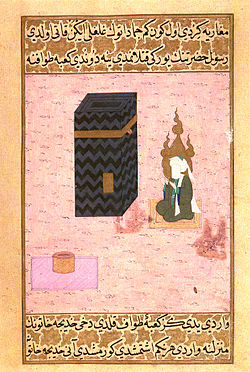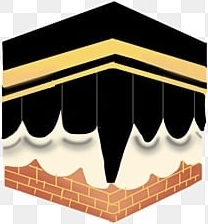The Kaaba (Arabic: ٱلْكَعْبَة, romanized: al-Kaʿba, meaning ‘the Cube’), also spelled as Kaʽba, Kaʽbah, or Kabah, is sometimes referred to as al-Kaʽba al-Musharrafa (Arabic: ٱلْكَعْبَة ٱلْمُشَرَّفَة, romanized: al-Kaʿba l-Mušarrafa, meaning ‘the Honored Ka’ba’). It is a stone structure located at the heart of Islam’s most significant mosque and sacred site, the Masjid al-Haram in Mecca, Saudi Arabia. Muslims regard it as the Baytullah (Arabic: بَيْت ٱللَّٰه, meaning ‘House of God’) and it establishes the qibla (Arabic: قِبْلَة, meaning ‘direction of prayer’) for Muslims globally. The present-day edifice was constructed following the damage inflicted on the original building by a fire during the Umayyad siege of Mecca in 683 CE.
In the early days of Islam, Muslims oriented themselves towards the Al-Aqsa Mosque in Jerusalem as their qibla during prayers, before the direction was altered to face the Kaaba, a change believed to have been prompted by a revelation of a Quranic verse to Muhammad.
Islamic tradition holds that the Kaaba has been reconstructed multiple times throughout history, most notably by Ibrahim and his son Ismail, when Ibrahim returned to the valley of Mecca years after leaving his wife Hajar and Ismail there at Allah’s behest. The act of circling the Kaaba seven times in a counterclockwise direction, known as Tawaf (Arabic: طواف, romanized: tawaaf), is a mandatory rite for completing the Hajj and Umrah pilgrimages. The region surrounding the Kaaba where pilgrims perform this act is referred to as the Mataaf.


The Kaaba and the Mataaf are frequented by pilgrims daily throughout the Islamic year, with the exception of the 9th of Dhu al-Hijjah, recognized as the Day of Arafah, during which the cloth that covers the structure, referred to as the Kiswah (Arabic: كسوة, romanized: Kiswah, lit. ‘Cloth’), is replaced. Nonetheless, the most notable surge in their numbers occurs during Ramadan and the Hajj, when millions of pilgrims convene for Tawaf.[7] As reported by the Saudi Ministry of Hajj and Umrah, a total of 6,791,100 external pilgrims participated in the Umrah pilgrimage in AH 1439 (2017/2018 CE).[8]
Etymology
In Arabic, the term Ka’bah (Arabic: كعبة) literally translates to cube. Consequently, the most widely accepted etymology suggests that the Kaaba derives its name from its kaʿb shape.[9] Some scholars have raised doubts regarding the pre-Islamic cubic interpretation of kaʿb, exploring alternative etymological origins.[10] One contested theory posits that the name “Kaaba” may be linked to the southern Arabian or Ethiopian term “mikrab”, which denotes a temple.[11][12] Another theory connects it to Kʿbt, which is associated with the Kaaba of Najran.[13]
History
See also: Pre-Islamic Arabia and Religion in pre-Islamic Arabia
View of the Kaaba, 1718. Adriaan Reland: Verhandeling van de godsdienst der Mahometaanen
Background
The architectural design of the Meccan Kaaba is reminiscent of several pre-Islamic cult structures, which have generally been categorized as Kaabas. These structures are primarily identified within the Arabian Peninsula, although some have also been discovered in other areas, including the Kaaba of Zoroaster.[14] Imoti asserts that there were many such Kaaba sanctuaries in Arabia historically, although only the Meccan Kaaba was constructed from stone.[15] The Black Stone of the Kaaba has been likened to pre-Islamic cultic stones known as baetyls, which were often black, believed to originate from meteorites, and were revered in homes or temples dedicated to specific deities.[16] Imoti contends that the other Kaabas also purportedly possessed their own versions of the Black Stone. There was a “Red Stone”, in the Kaaba of the South Arabian city of Ghaiman; and the “White Stone” in the Kaaba of al-Abalat (near modern-day Tabala). Grunebaum, in Classical Islam, points out that the experience of divinity of that period was often associated with the fetishism of stones, mountains, special rock formations, or “trees of strange growth.”[17]
In Islamic cosmology, the Zurah pilgrimage site was the precursor to the Kaaba.[18]
Pre-Islamic Arabia

Crone has cast doubt on the claim that Mecca was a major historical trading outpost.[20][21] Other scholars such as Glen Bowersock disagree and assert that it was.[22][23]
In pre-Islamic Arabic poetry attributed to Zuhayr ibn Abi Sulma, the builders of the Kaaba are said to be the Quraysh and Jurhum tribes.[24] Christian J. Robin argues that the Kaaba may have become prominent in the last decades of the 6th century in the aftermath of the military defeat of Abraha by the Quraysh.[25] However, Peter Webb, based on pre-Islamic poetry, argues that the Kaaba was never a prominent site of pilgrimage and that it largely played a local role in Western Arabia as opposed to a pan-Arabian one.[26]
According to Islamic tradition, the pre-Islamic Kaaba was a site of worship for various Arabian Bedouin tribes, who would make pilgrimage once every lunar year, setting aside their tribal feuds.[27] The Kaaba hosted 360 pagan idols (potentially one representing each day of the year) including sculptures and paintings before Islam, notably including a statue of Hubal, the principal idol of Mecca.[28][29] paintings of angels, of Ibrahim holding divination arrows, and of Isa (Jesus) and his mother Maryam (Mary), which Muhammad spared.[30] Undefined decorations, money and a pair of ram’s horns were recorded to be inside the Kaaba.[28] The pair of ram’s horns were said to have belonged to the ram sacrificed by Ibrahim in place of his son Ismail as held by Islamic tradition.[28] Islamic tradition traces the polytheism of the Kaaba to the descendants of Ishmael who settled around the Zamzam Well and gradually turned it away from its original monotheist practice during the time of Abraham.[31] The Book of Idols by Hisham ibn al-Kalbi describes the origins of idolatry at the Kaaba: about 400 years before the birth of Muhammad, a man named ‘Amr bin Luhayy, who descended from Qahtan and was the king of Hijaz, placed an idol of Hubal on the roof of the Kaaba. This idol was one of the chief deities of the ruling Quraysh tribe. The idol was made of red agate and shaped like a human, but with the right hand broken off and replaced with a golden hand. When the idol was moved inside the Kaaba, it had seven arrows in front of it, which were used for divination.[32] To maintain peace among the perpetually warring tribes, Mecca was declared a sanctuary where no violence was allowed within 30 km (20 mi) of the Kaaba. This combat-free zone allowed Mecca to thrive not only as a place of pilgrimage, but also as a trading center.[33] A king named Tubba’ is considered the first one to have a door be built for the Kaaba according to sayings recorded in Al-Azraqi‘s Akhbar Makka.[34]
Alfred Guillaume, in his translation of the Ibn Ishaq‘s seerah, says that the Kaaba itself might be referred to in the feminine form.[35] Circumambulation was often performed naked by men and almost naked by women.[31] It is disputed whether Allah and Hubal were the same deity or different. According to a hypothesis by Uri Rubin and Christian Robin, Hubal was only venerated by Quraysh and the Kaaba was first dedicated to Allah, a supreme god of individuals belonging to different tribes, while the pantheon of the gods of Quraysh was installed in the Kaaba after they conquered Mecca a century before Muhammad’s (Peace be upon him) time.
Credit: Wikipedia
Baitullah – The House of Allah – Baitullah.com

